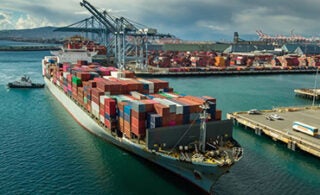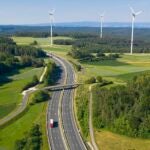- Resources
- Raising anchor: The urgency of energy transition in maritime shipping
Resources
Raising anchor: The urgency of energy transition in maritime shipping
Published: April 18, 2023 by Deanna Coleman
The shipping industry will be gathering in Singapore this month, and carbon emissions will be high on the agenda. Maritime shipping is essential to today’s extended supply chains but is a major emissions source –making up 3% of worldwide greenhouse gas emissions. Without rapid action to reshape maritime fueling, shipping emissions could increase 130% from 2008 levels by 2050. Fleet owners, companies that rely on global supply chains, and investors in this capital-intensive industry are increasingly focused on how to decarbonize shipping on a path to net zero.
For both companies and investors, this transition presents risks and opportunities. Our deep dive report on the industry, Maritime Makeover, offers investors a guide to navigating the changes ahead to minimize financial, technological, and other risks on the path to decarbonization. It discusses how measures ranging from slow steaming, to vessel upgrades, to piloting zero-carbon fuels such as green ammonia and green methanol can show results now and prepare companies for the changes that lie ahead.
Important differences among shipping categories will drive how container, bulk, and tanker shippers approach the task at hand. Different market segments bring their own considerations to the transition. For some alternative fuels might be a priority, while for others the focus is upgrades and retrofits.
For container shipping, which moves large volumes of freight in interchangeable boxes, a key challenge lies in procuring sufficient quantities of low- and zero-carbon fuels to meet the need and maintain route flexibility. Bulk shipping, which encompasses vessels with undivided internal spaces to transport commodities, faces similar fuel procurement challenges as well as a likelihood of more significant fleet retrofits to accommodate changes to vessel layouts. Tankers, which today largely transport fossil fuels, will have the most extensive changes to both vessels and operating models as global buying shifts toward new fuels and also falls in the face of electrification and renewable power for a range of energy needs.
The diversity and complexity of global maritime shipping means a range of fuels and solutions are needed. Beyond matching fuel options to particular vessel designs, shippers will need to weigh factors like fuel availability, cost, and emissions as compared with conventional bunker fuels. Reaching decarbonization targets by mid-century will require that shippers set ambitious goals today, pilot the fuels and technologies that will be needed, and disclose their emissions performance along the way.
To better understand what the energy transition pathway looks like, we talked with big players in each major shipping category about steps they are taking now.
Container shipping: A.P. Møller Maersk
Maersk – one of the largest global shipping operators active in ocean and inland freight transportation – accounts for 1% of transport and logistics emissions, and nearly 0.1% of all global emissions. Maersk’s decarbonization strategy focuses on methanol as a fuel that can be made via climate-neutral pathways and has potential for availability on a medium-term time scale (by 2030).
Maersk has ordered nineteen methanol-powered vessels from Hyundai Heavy Industries and signed letters of intent with multiple suppliers to signal demand for up to 40,000 tons of methanol per ship. As the vessels, which represent up to 7% of the company’s overall capacity, are put into use, they will provide operational insights that inform ongoing transition planning.
Bulk shipping: Nippon Yusen Kabushiki Kaisha (NYK)
NYK is Japan’s largest marine transporter of dry bulk shipping and accounts for 0.03% of worldwide industrial CO2 emissions, or 1.4% of worldwide transportation emissions.
NYK is one of the only bulk shippers piloting ammonia and methanol-powered technologies as part of a lower-carbon fuel transition plan. An NYK official said the company has ordered an ammonia-fueled tugboat and bulk vessel, expected to enter service in 2024 and 2026, respectively, and is also exploring the purchase of methanol-powered vessels. This multi-fuel testing plan reflects uncertainty over which fuels and their production pathways will be the most successful and cost-effective in particular applications. Another key question will be how the fuels’ emissions throughout production and use compare to conventional alternatives.
Tanker shipping: Euronav NV
Euronav is a Belgian international shipping enterprise focused on crude oil and petroleum products, ranking in the top three by carrying capacity. Euronav is exploring transition fuels for its own use, as well as how transporting alternative fuels can bolster its business strategy as its customers transition to lower-emissions products. Following trials of a 50% biofuel blend in 2021, Euronav claimed a 25.8% total emissions reduction with no significant difference in operations. The company also aims to purchase ammonia-fueled vessels that have the potential to reduce emissions by up to 93% per journey, depending on how the fuel is made.
Charting The Course
Preparing for future fuels is important, but there are also steps that shippers can take today to reduce fleet emissions. Such measures include adjusting shipping routes, reducing vessel speeds, and improving the energy efficiency of ships. All relevant strategies should be included in a comprehensive climate transition action plan. Also important is policy leadership in global, regional, and national settings to develop strong incentives and supports.
The maritime shipping industry is increasingly coming together around the need to explore new fuels and operational models to reduce emissions. For the finance sector, tracking how shipping companies and their customers are engaging in decarbonization can be an important indicator of their exposure to risk as the market moves toward a decarbonized future. Tomorrow’s leaders can raise the anchor now by matching forward-looking planning with tangible actions that cruise the sector along decarbonization pathways.


